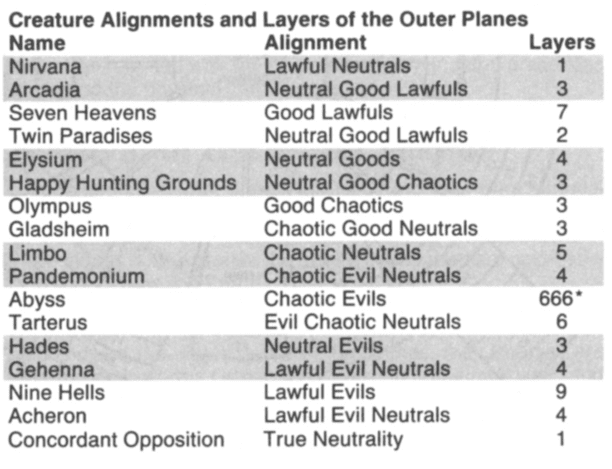
The Planes
The outer planes are also called the Planes of Power since they are the homes of the most powerful extraplanar beings in the known planes of existence. They have a mixture of elements that supports a rich diversity of life, often (but not always) similar to life on the Prime Material planes. It is unknown whether this is because the inhabitants of the outer planes affect the creatures on the Primes, or because the Prime planes impose order on the outer planes.
The conventional view of the outer planes is of a great wheel divided into 16 pieces. Each piece is the upper layer of a plane and is joined to the upper layers of the two planes adjacent to it. Planes have an variable number of planar layers, also called levels. In the center of the wheel, joined to it by the Astral plane, are the Prime Material, Ethereal, and inner planes.
The above is accurate as far as it goes, but things are more complicated than that. Each planar layer is physically infinite in the same manner as the Prime Material, inner, and Ethereal planes. The Astral plane coexists with the first (uppermost, closest to the Astral) layer of each plane, but there are also conduits that reach the deeper layers, enabling rapid movement of beings and great powers from one plane to another. Each layer of the outer planes contains a number of different realms ruled by various Powers or forces.
It has also been revealed that there is another outer plane that does not fit into the wheel concept but has strong connections with four mutually opposing planes. This 17th plane, the plane of Concordant Opposition, is usually placed below the wheel. In this picture, the outer planes look like a cup filled with an Astral soup in which various alternate Prime Material planes float. The planes are roughly aligned according to good versus evil and Law versus Chaos. The plane of Concordant Opposition is often referred to as a plane of true neutrality.
There are 17 known outer planes as listed:

Moving and Traveling in the Planes
All travel to the outer planes involves moving through the Astral-there are no outer planar vortices that connect directly between the outer and Prime planes. The degree to which the traveler must move through the Astral is determined by the method of movement.
Three common methods are conduits, spell effects, and color pools. Conduits and spell effects move the traveler rapidly into the outer planes, while astral color pools enable travelers to check out an area before they enter. Conduits are also called wormholes or gates.
They usually have one mooring in the Prime Material and the other in a specific location in an outer plane (though there are also conduits that lead from one outer plane to another). The Prime Material end is often a temple complex or other location dedicated to a particular power, while the other terminus is in part of the realm ruled by that Power. This terminus is not necessarily on the top layer of the outer plane.
Travel via conduit through the Astral is rapid (one round) and not noticed by the travelers, so it appears that the travelers step off the Prime and directly into the desired outer plane. Astral beings cannot affect those in conduits. Conduit travel has the advantage of bringing the physical body along without a trip into the Astral plane. Its disadvantages are threefold: a gate must be found in the Prime plane, the gates are often guarded, and the terminus location may not be friendly to the traveler.
Conduit travel is safest when the traveler is expected or is powerful enough to deal with any hazards on the far side. Conduit travel takes those who enter the conduit and all they wear and carry into the other plane. The travelers cannot break the sides of the conduit to enter the Astral plane (indeed, most travelers are unaware that the Astral is traversed in the course of conduit travel). Only a few high-level spells enable the caster to move directly into the outer planes. Each spell has advantages and disadvantages.
The clerical spell, plane shift, transports the caster and his companions to any known plane. The destination plane is determined by the material component of the spell, a tuning fork of a particular material. A single note brings the caster to the top layer of the outer plane attuned to the tuning fork. Deeper regions are said to be reached by combinations of chords, so that a group of random chords may take the player to a random layer of the Abyss.
The plane shift spell grants little control over the part of the plane the caster arrives in. While this does not matter in the amorphous inner, Ethereal, and Astral planes, the widely varying natures of the outer planes make random placement rather unpleasant. This spell is usually guided by a basic idea of where the caster wants to go in that planar layer, so the drop-off point is usually not too far off. Use the following table for travel into the outer planes by the plane shift spell.
The clerical and magic-user gate spell can also reach the outer planes by summoning a Power and beseeching it to return with the caster (and any allies) to another plane. This is not beyond the abilities of any Power or Demi-Power, but most operate according to the following rules: A Power will not transport individuals to another Power's realm if the other Power is of equal or higher level; a Power will not let a group of mortals into its home plane to wreak havoc; a Power will agree to such transportation if there is sufficient reward for the Power to do so.
The teleport without error spell and the succor spell can also span the planes. The former requires some knowledge of the destination, with the standard chance of teleporting too high or low. The latter is an automatic teleport that brings the characters to an outer plane only if that spell was originally cast in that outer plane.
Astral Projection Astral Traveler
Several devices duplicate spell abilities. The amulet of the planes transports the wearer randomly into the first layers of the outer planes in the same manner as a plane shift spell. In this case, the DM or GM selects a point of arrival and rolls to see how far away the character lands from it. The well of many worlds transport the user into the first layer of any outer plane or any Alternate Material plane, at the choice of the DM. or GM All of the preceding spells and items bring the travelers physically into the plane, with all worn and carried items.
The frequent choice of extraplanar travelers, such as adventurers seeking to sneak into the lair of a petty demigod or arcanadaemon lordling, is the Astral color pool. The passage into the Astral plane and location of a color pool enables the traveler to view the terrain before entering it. He can also move the viewpoint to a safe location before entering the plane.
The disadvantages of this method of travel have been mentioned earlier, including the possible detection of the Astral viewing point and that only the topmost layers of the planes can be reached. A traveler who is physically in the Astral plane can enter an outer plane by passing through the appropriate color pool. If the region is inhospitable to mortal life, the traveler can be injured or slain. The physical traveler brings all his magical items through the portal with him, even the ones that lose their magical auras in the new plane.
An astrally projected traveler can also enter a color pool, but the passage creates a new body out of materials in the other plane. (If the traveler enters in a relatively terrestrial environment, his new body is close to normal flesh in appearance and effect). The traveler who attempts to materialize in an extraplanar pool of magma becomes a magma-like creature-immune to fire but doubly affected by water.
For this reason care is advised for the traveler who manifests in a strange form (one cautionary tale involves a traveler who became solid rock and eroded as he moved) DMs and GMs are encouraged to be fiendishly creative in assigning advantages and disadvantages to forms that players create.
The astral individual retains his silver cord on the new plane. It is invisibly attached to the traveler and disappears after 10 feet back into the Astral. The astrally projected traveler can still return to his original body in 1d100 rounds (he expresses that desire and is immediately returned to his original body). If the silver cord is cut while the traveler is in the outer planes, the traveler does not perish.
What happens is that he can no longer return to the Astral or his original body without casting another astral spell and reinhabiting his original form. The traveler is immediately aware when his silver cord has been snapped. This is usually a sign that one of the more powerful natives of the plane is aware of the character's presence.
When an astral traveler passes through a color pool, any magical items that will not function in the outer plane (that is, totally lose their magical abilities) do not pass through the pool but return to the traveler's original body (if possible). If such items cannot be reunited with the original body, their astral presences erode and the physical item decays in 1d10 turns.
Curious to read more: Understanding Demiplanes: An Exploration into the Unknown






